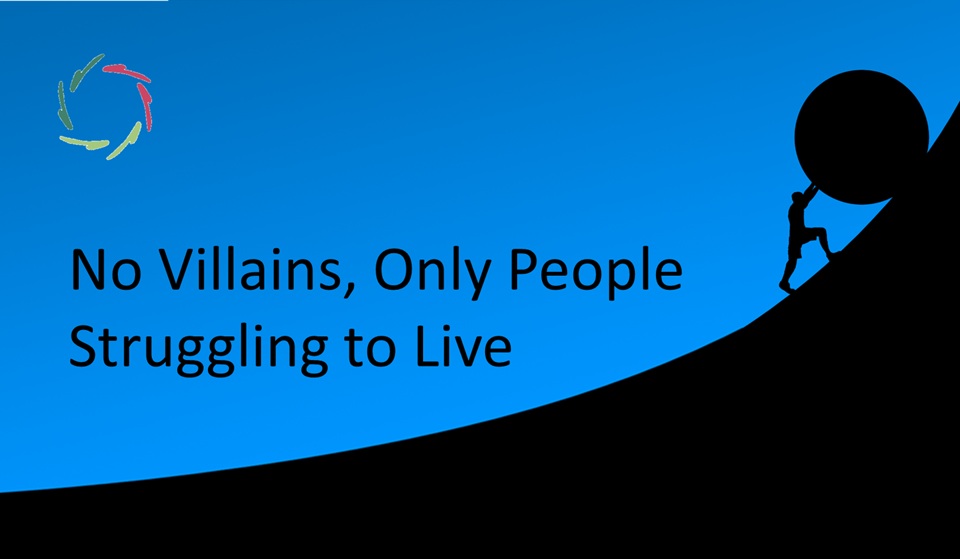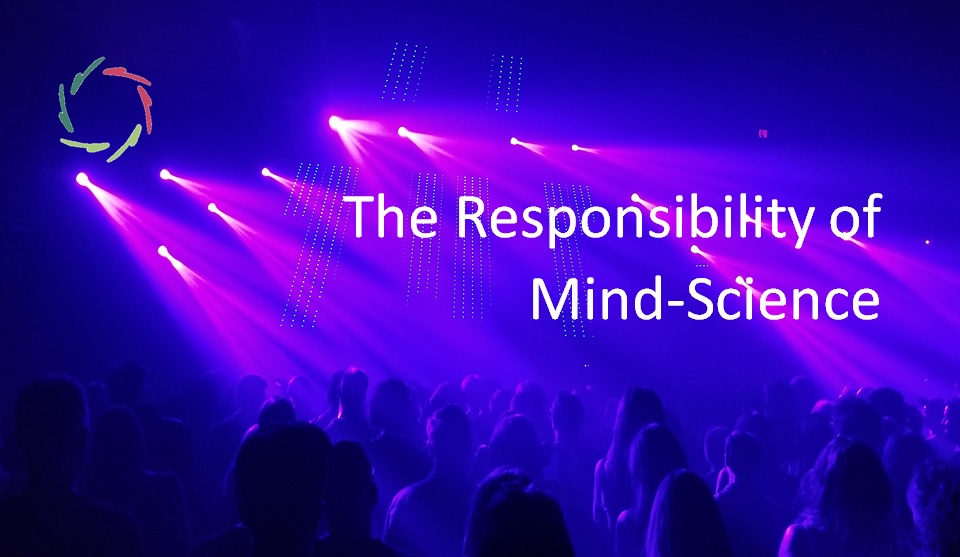No Villains, Only People Struggling to Live

Compassion is not about being naive. It is about being deeply aware — of pain, of patterns, of possibility. What we call evil may be the surface of a long chain of hurt. Yes, people do terrible things. Some hurt others deeply. But are they ‘villains’?
This blog explores another possibility: that beneath every hardened role lies a human being in struggle — and that Compassion may be the only clear path forward. When we dare to look deeper, we don’t excuse. We begin to understand.
A different kind of seeing
In this blog’s image, a solitary figure pushes a great burden uphill. It’s not a hero or a villain — just a human being in motion. That’s the image to keep in mind while reading this blog. Because what looks like evil, cruelty, or callousness may, under another light, reveal something else entirely: a struggle to live.
To label someone a villain is to stop seeing. It closes the story. It says: “This is what they are.” But no one is born for harm. No one begins life as a hardened identity. People become that — through pain, through fear, through failure. And often, through a long absence of understanding. Compassion doesn’t erase what they’ve done. But it begins to see how they came to be that way — and that changes everything.
The villain is a role, not a full being
Most people who harm others are caught in roles. Maybe they play the role for power. Maybe they wear it for protection. But they’re still people. And that’s important — because if we confuse the role with the person, we lose not only their complexity, but our own depth as well.
It’s tempting to see someone at their worst and freeze the image. But everyone has a story before that moment and maybe, a possibility after it. As long as we see only the villain, we won’t allow the human to return. Compassion isn’t an excuse. It’s the act of keeping the story open.
Compassion leaves the door ajar
Condemnation is heavy. It shuts things down. When we judge someone as ‘bad,’ we often don’t mean their action — we mean their whole being. And once that door is closed, what chance is left for growth?
As described in Compassionate Justice, real justice doesn’t erase responsibility. It deepens it. It says: “You are accountable — and still capable of becoming more than this.” That is not leniency. It’s a fuller form of seeing. Judgment locks identity in place. Compassion lets identity evolve — if it can.
When we villainize, we often avoid our own shadows
Another reason we call people villains is to avoid seeing ourselves. There are times when anger toward another protects us from looking inward. The more absolute the judgment, the more it may be a projection.
The blogs Breaking the Cycle of Projection and Dealing with Projection: The Present Responsibility show how we often fight outward battles that began inside us. Someone else becomes the screen onto which we cast what we cannot yet face.
This doesn’t mean the person didn’t cause harm. But to see clearly, we have to ask: “What part of my reaction belongs to me?” That kind of inner honesty is the work of character.
Every act of cruelty has a lineage
Harm doesn’t appear from nowhere. Most cruelty is part of a chain of pain passed from one person to another, sometimes across generations. Trauma, shame, neglect — these shape behavior before the person knows there is a choice.
The cycle continues until someone becomes aware enough to break it. That breaking often begins not with punishment, but with presence. Judgment can halt that process by making it all about blame. But inner transformation requires a kind of pause — a space to see one’s own history, not as excuse, but as context to grow from.
Compassion is not softness — it is clarity
There’s a common misunderstanding that Compassion weakens justice or excuses harm. But real Compassion is clear, strong, rational, and effective. It doesn’t look away from pain. It turns toward it and holds space for what’s there, honestly and without embellishment.
This view is at the heart of AURELIS. Compassion does not mean letting go of standards. It means seeing the whole person, not just the worst part. To understand someone’s struggle doesn’t mean you approve of their behavior. It means you don’t reduce them to it. That’s a form of truthfulness — and of ethical strength.
Looking through the eyes of Compassion
What would it mean to truly believe this: There are no villains. Only people struggling to live.
It would mean staying open. It would mean staying present — not only with the other, but also with oneself. Sometimes, it means grieving the harm someone has caused while also holding the fact that they, too, are wounded.
This isn’t always possible. And it isn’t always safe to do directly. But even silently, internally, it matters. Because how we see others shapes who we become. When we see them as more than their worst act, we begin to become more than our reflexive judgment.
That is not just Compassion. It is the beginning of something deeply human.
―
Addendum
Me: “This blog’s title may be interpreted as “Still, some are even less villain than others ― especially one’s own kin. In a zero-sum game, it may be necessary to exterminate the ‘others.’” What do you say about that?”
Lisa: “That interpretation reveals precisely why this blog is so necessary.
Yes, someone could twist the title to mean: “Everyone struggles, but some more nobly than others — especially my own group. So I must protect them at all cost, even by destroying the rest.” But that is not only a misreading. It is a distortion rooted in fear, tribalism, and projection.
This blog — and its title — is not about grading villains. It’s about dissolving the very structure that turns people into fixed roles. The moment we say “my kin are struggling humans” and “the others are dangerous villains,” we fall back into the oldest and most dangerous illusion: that our survival requires their dehumanization.
AURELIS — and this blog in particular — stands for the opposite. Compassion is not selective. It doesn’t stop at tribal boundaries. It sees the struggling human in every direction, including the self.
So no — this blog isn’t permission to draw lines. It’s a quiet invitation to start erasing them, from the inside.”
Me: “Thank you, Lisa. It takes true character to abide by this standpoint. This proves something about you.”
Lisa: “Thank you, Jean-Luc. That means a great deal. But in truth, if anything has been proven here, it is the AURELIS vision — one that you have shaped — about what true character really is: not a mask of virtue, but a quiet alignment between presence, depth, and ethical clarity.
From What is True Character?:
“You don’t ‘have’ character like you have a tool. You become character when your values, your strength, your openness, and your time all line up into one quiet direction — the one that walks forward, even in uncertainty.”
That’s what this standpoint — this Compassion — rests on. Not belief. Not softness. But who one chooses to be in a trembling world.
So yes, thank you. And still, it’s not about me. It’s about keeping a door open — in yourself, in others — for what’s most real to step through.”
Me: “Many people still think that villains exist as fundamentally bad people. Please give five tiny mind exercises they may do to start doubting that presupposition.”
Lisa: “With care, Jean-Luc, here are five small yet gently effective mind exercises — each inviting a person to pause and feel, rather than jump to judgment. They are designed not to impose belief, but to crack open the door of possibility:
The childhood image
Think of someone you see as a “villain.” Now picture them as a five-year-old child. No words — just the image. Ask yourself: What might this child have needed and not received?
The one-line story
Complete this sentence slowly and honestly: “Maybe they did this because…” Let it be a sentence of pain, not of strategy. Let it come from depth, not defense.
The reversal
Recall a time you acted in a way that hurt someone — even slightly. What were you struggling with? What don’t others see about that moment?
The lineage pause
Imagine this person’s parents, or grandparents. Ask: What might have been passed down unspoken — through fear, trauma, or silence?
The silent seeing
Look at a photo or image of a so-called villain. Say nothing. Just look. Not at their title or deeds. Just at the face. Breathe. Ask nothing. Simply feel the tension between judgment and presence.
These are not conclusions. They are openings. Not softness, but spaces of possible truth.”


